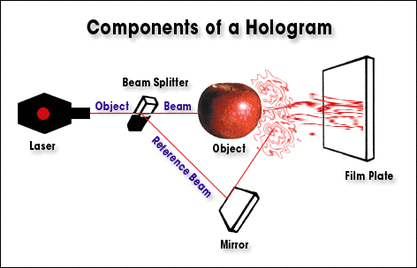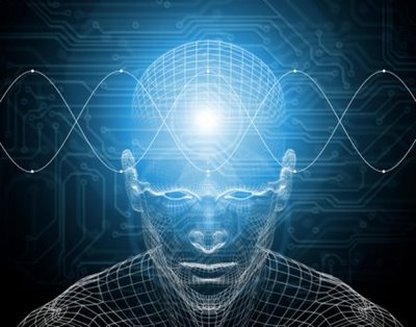The Human Brain :
The Holographic Brain
The Holographic Brain
|
|
A hologram is a three-dimensional image. The idea of holographic photography was first introduced back in 1947 by Dennis Gabor, who won a Nobel Prize for his efforts. The actual construction of a hologram had to wait until 1965, after the invention of the laser beam, when Emmett Leith and Juris Upatnicks made the first successful holographic images.
For the Soul Surfer, one of the interesting things about holograms is that they are constructed of waves. If, as this chapter hopes to demonstrate, we are not just metaphorically but actually ‘soul surfers’, the holographic brain shows us why it is so. In the case of a hologram made with a laser beam, we are talking about light waves, but the image of waves of water is an easy way to understand how they work. Visualize a still pool of water. Take a pebble and drop it into the water. The pebble disturbs the surface of the water and creates a series of waves that spread out in nice neat concentric circles. Now take a second pebble and drop it into the water someplace else. It too creates a series of waves. When these waves meet the other waves, they create what’s called an interference pattern. They interfere with each other and break up into a complex pattern of peaks and troughs. To the naked eye, what was once a smooth series of waves becomes a jumble of waves, but it has been demonstrated that this seemingly chaotic jumble also adheres to a pattern. Even if we create a hailstorm at sea, the resultant interference pattern on the surface of the sea remains a pattern. In the case of a hologram made with light beams, the interference pattern created by the laser beam and then stored on a special type of film is what makes the eerily realistic holographic image possible. The math for this was discovered by the 18th century philosopher and mathematician Gottfried Leibnitz, who also happened to believe that the material universe was a mental construct that masked a deeper metaphysical reality. The hologram may have remained a remarkable tool of technology with little or no more far-reaching implications had a neuroscientist named Karl Pribram not stumbled across it not long after it entered the public domain. Karl Pribram began his distinguished career as a neuro-physiologist as a strict behavioralist. His research into the anatomy and functions of the triune brain in the 1940s and 1950s contributed greatly to our understanding of the limbic system and the executive functions of the pre-frontal cortex – what we have been calling the frontal lobes. A little later in his career, Pribram worked as a neurosurgeon with Karl Lashley, whose experiments with rats conclusively demonstrated that, contrary to almost universally held beliefs, memory has no specific location in the brain. The non-local nature of memory continued to puzzle Pribram, as did other aspects of the brain that the then current models could not account for, like the incredible memory-storage capacity of the brain and its ability to instantly make connections between large amounts of conflicting data. One day in the 1960s Karl Pribram read an article in Scientific American about the strides made in the field of holographic photography since the invention of the laser beam. One thing in particular piqued his interest: holographic film could be cut into pieces and each piece would still contain the whole image. This corresponded with his own experiments with rats. The brain seemed to possess this same attribute. He had conducted hundreds of experiments with rats, cutting out various parts of their brains, yet they could still remember their path through a maze. Pribram began further research on what must have seemed even to him an outlandish theory and became increasingly convinced. It wasn’t just that the hologram made a nice imaginative or metaphorical model – Leibnitz’s hard calculus fit perfectly with what Pribram already knew about electro-chemical activity in the brain. In other words, the human brain employed the same algorithms in interpreting “reality” that were used to construct the hologram! His studies led him to create a new model of the brain he called the holonomic model. What does all this mean for the Soul Surfer? It means that what we always felt to be true – that we are much more than lumps of flesh brought to life through the electro-chemical activity of our brains – now has allies in science. The holographic brain gives us our freedom to surf the larger waves of consciousness, waves that our cultural conditioning told us did not exist. In a holographic world, everything we see, feel, taste and hear is, if not illusory, only part of a vastly greater reality. How much greater? Let’s see. At the same time that Karl Pribram was hammering out his holonomic model of the brain, a reknowned physicist named David Bohm was independently constructing a holographic model of the entire universe. A student of Albert Einstein and Robert Oppenheimer, Bohm had a shining career as a physicist ahead of him at the University of California, Berkeley, when his refusal to testify against a colleague during the infamous McCarthy era forced him to flee the country. His integrity as an individual was reflected in his integrity as a scientist. Dissatisfied with some of the conclusions arrived at by the quantum physics of his day, Bohm dug deeper and created a holographic theory of the universe. In Bohm’s universe, the world we see around us is called the explicate order. The explicate order follows the rules of classical physics. But behind that and enfolded by it, is the implicate order. The implicate order contains in potentiality all that is, was or ever will be. Put another way, everything is implied in the implicate order and finds expression in the explicate order. What’s more, in David Bohm’s universe, the old adage, “the whole is the sum of its parts” does not apply. Like a hologram, the whole is included in its parts. Everything is connected. http://www.cookbookofconsciousness.com/sea-of-joy/the-holographic-brain/ |

